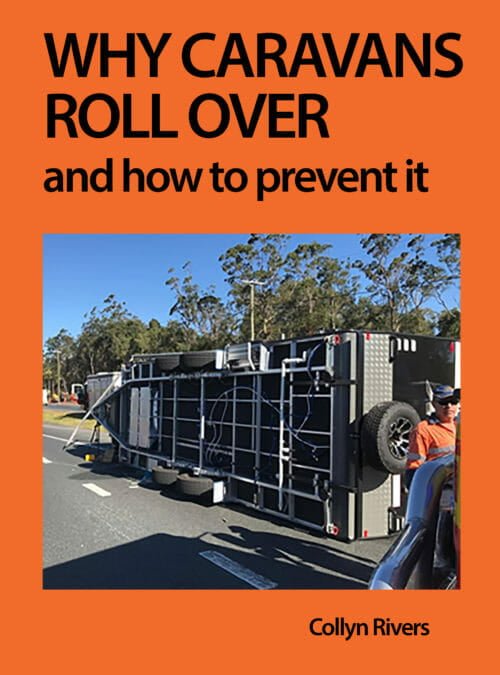by Collyn Rivers
Caravan weight safe to tow
The maximum caravan weight safe to tow depends on what tows it. This article by Collyn Rivers explains why – and how to know what it is.
In earlier times, what caravans were considered safe to tow was based on their weight relative to that of the towing vehicle. That, however, was in an era when most new caravans were four or so metres long, weighed 1200-1500 kg (2650-3300 lb), and rarely towed above 80 km/h. Where that length and weight still applies, such trailer/tow vehicle weight ratio remains fine. It is true, for example of (sanely laden) camper trailers.
With caravans longer than 4 metres, the limiting weight largely relates to where the weight is distributed. If over 6 metres that weight distribution is critical. This applies both to design and loading.
Caravan weight safe to tow – why this matters
Here’s how to feel for yourself how and why this matters.
Hang any suitable bar (a broom handle will do at a pinch) by a rope. Add a couple of weights as shown below.
![[cara_up] weight safe to tow - depends on what tows it 1 Caravan weight. Bar-simulation illustration](https://rvbooks.com.au/wp-content/uploads/2016/02/bar-simulation-close.png)
This bar simulates a caravan with the weight close to its centre. Hold the bar and turn it – like a caravan swaying. You will find that, even with heavy weights, it turns and stops turning with ease. Pics: rvbooks.com.au
Now try it with the weights like this:
![[cara_up] weight safe to tow - depends on what tows it 2 Caravan weight. Bar simulation web wide](https://rvbooks.com.au/wp-content/uploads/2016/02/bar-simulation-web-wide-1024x505.jpg)
This simulates an end heavy caravan exactly the same weight. Hold and turn it as before. You will find it surprisingly hard to start and stop.
The further apart the weights, the harder it is to start and stop moving. Also, (as with a tow vehicle and caravan) the lighter you are, relative to the length of the bar and position of the weights, the harder it is to stop and start moving. Take care if you try this with heavier weights. The force may push you over! The same applies if you use a longer bar. Try it also with a heavier weight at the rear.
If you do not access to a barbell and weights you can do this by holding a bottle of wine in each hand – then turn while turning rapidly fully extended both arms sideways. Do this on a still revolving chair and you may have a surprise. (Any wine will do, but drink it afterwards).
Moments along a beam
The above is known technically as ‘Moments Along a Beam’.
![[cara_up] weight safe to tow - depends on what tows it 3 seesaw](https://rvbooks.com.au/wp-content/uploads/2016/02/seesaw.jpg)
The ‘effect’ of weight on a pivoted beam (and a caravan chassis) relates to its distance from the pivot (axle). Pic: original source unknown.
Unless weight is more or less central, a short heavy van is safer to tow than a long van of the same weight. The see-saw effect also shows it is not good to have anything heavy at either end. Locate tool-boxes, batteries, spare wheels etc as close to the axle/s. Never at the far ends.
You have some control over this. The heavier whatever you load, the closer it needs to be to the axles. Never load anything heavy up-front and ‘balance’ that by weight at the rear.
Because of these effects, a long caravan needs a much heavier tow vehicle than a short caravan of the same weight. Some locally made ‘vans are (in my opinion) far too long to be towed safely by anything short of the big Fords etc.
Relates also to caravan length
You should have no problem towing a correctly laden 3.5-metre caravan by a laden tow vehicle the same weight. But you are pushing your luck with a 6 to 6.5-metre local product. I would only tow it with a vehicle at least 30% heavier.
If seeking a caravan longer than 7 metres I seriously advise readers to consider the dynamically more stable fifth-wheel caravan format.
For a warning and explanation of why many caravans are overweight see Caravan tare weight issues/
A more technical explanation is at: Caravan and tow-vehicle dynamics/
Information on tow ball mass is at: Caravan nose weight/
See also Why Caravans Roll Over – also Reducing caravan sway. For info on fifth-wheelers see Fifth-wheel caravans are safer/
If you find this article helpful you will find my books even more so. They include the Camper Trailer Book, Caravan & Motorhome Electrics, Solar That Really Works for RVs), Solar Success (for home and property systems), and the all-new Caravan & Motorhome Book. For information about the author – see Bio.
Please add a Link from this article and/or any of the above to any related forum query. This assists and warns others.




